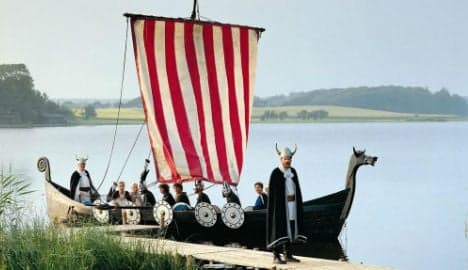Were Denmark's Vikings economic migrants to the UK?

As many as 35,000 Danish Vikings moved to England to start a new life between 800AD and 900AD, a new study has estimated, with the researcher likening them to economic migrants today.
The study, published in the journal Antiquity, contradicts the ‘People of the British Isles’ project, which used DNA evidence to argue that there was “no clear genetic evidence of the Danish Viking occupation“.
Jane Kershaw, a postdoctoral fellow at University College London, used her knowledge of the archeological evidence for Danish settlement, and combined it with the DNA expertise of Dr Ellen Røyrvik from Warwick University, who worked on the Peoples of the British Isles project.
“We consider the details of certain assumptions that were made in the study, and offer an alternative interpretation to the above conclusion,” the two wrote in their abstract. “We also comment on the substantial archaeological and linguistic evidence for a large-scale Danish Viking presence in England.”
Kershaw told the Danish magazine Videnskab that she viewed the Danish Vikings as economic migrants little different from those arriving in the UK and Denmark today.
"At that time, there may not have been enough resources in the Vikings' homeland, but in eastern England the Vikings found an agriculturally rich area," she said.
"We are currently living in a time of large-scale migration,” she added. “We must open our eyes to the fact that the same thing happened 1,000 years ago, rather than think of our ancestors as people who just stayed at home and never left their farms.”
According to Professor Søren Sindbæk, a researcher at the University of Aarhus, the Danish Viking migrants caused so much resentment amongst the Anglo-Saxons that in 1002, King Æthelred the Unready gave orders for them all to be killed in what became known as the St. Brice's Day massacre.
“They were certainly getting tired of immigration in England around the 1000s,” Sindbæk told the magazine. “We do not know how many ended up being killed, but there is no doubt that a mass murder took place.”
Sindbæk said that the massacre suggested that immigration was an issue among Britain's residents even then.
“The episode underlines the fact that the Vikings were such a large population, that Danes was seen as a political force and in some contexts a problem."
Æthelred certainly justified the massacre in a Royal Charter in terms reminiscent of today’s most incendiary anti-immigration language.
The Danes had “sprung up in this island, sprouting like darnel ryegrass [a weed] amongst wheat”, he complained.
Therefore, he argued, they had to be “destroyed by a most just extermination.”
Comments
See Also
The study, published in the journal Antiquity, contradicts the ‘People of the British Isles’ project, which used DNA evidence to argue that there was “no clear genetic evidence of the Danish Viking occupation“.
Jane Kershaw, a postdoctoral fellow at University College London, used her knowledge of the archeological evidence for Danish settlement, and combined it with the DNA expertise of Dr Ellen Røyrvik from Warwick University, who worked on the Peoples of the British Isles project.
“We consider the details of certain assumptions that were made in the study, and offer an alternative interpretation to the above conclusion,” the two wrote in their abstract. “We also comment on the substantial archaeological and linguistic evidence for a large-scale Danish Viking presence in England.”
Kershaw told the Danish magazine Videnskab that she viewed the Danish Vikings as economic migrants little different from those arriving in the UK and Denmark today.
"At that time, there may not have been enough resources in the Vikings' homeland, but in eastern England the Vikings found an agriculturally rich area," she said.
"We are currently living in a time of large-scale migration,” she added. “We must open our eyes to the fact that the same thing happened 1,000 years ago, rather than think of our ancestors as people who just stayed at home and never left their farms.”
According to Professor Søren Sindbæk, a researcher at the University of Aarhus, the Danish Viking migrants caused so much resentment amongst the Anglo-Saxons that in 1002, King Æthelred the Unready gave orders for them all to be killed in what became known as the St. Brice's Day massacre.
“They were certainly getting tired of immigration in England around the 1000s,” Sindbæk told the magazine. “We do not know how many ended up being killed, but there is no doubt that a mass murder took place.”
Sindbæk said that the massacre suggested that immigration was an issue among Britain's residents even then.
“The episode underlines the fact that the Vikings were such a large population, that Danes was seen as a political force and in some contexts a problem."
Æthelred certainly justified the massacre in a Royal Charter in terms reminiscent of today’s most incendiary anti-immigration language.
The Danes had “sprung up in this island, sprouting like darnel ryegrass [a weed] amongst wheat”, he complained.
Therefore, he argued, they had to be “destroyed by a most just extermination.”
Join the conversation in our comments section below. Share your own views and experience and if you have a question or suggestion for our journalists then email us at [email protected].
Please keep comments civil, constructive and on topic – and make sure to read our terms of use before getting involved.
Please log in here to leave a comment.